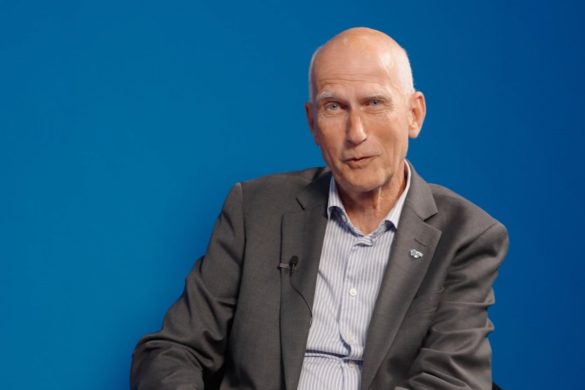Gian Luigi Lenzi (GLL): As Coordinator of the European Affairs Sub-Committee of the EAN, can you illustrate the role you give to EAN within the community of European Neurologists?
Wolfgang Oertel (WO): EAN represents all European Neurologists – from Uzbekistan to Portugal, from Malta to Island and neurologists from all countries which are and/or wish to be closely related to Europe – for example countries around the Mediterranean area. EAN is the one and only professional European society for neurologists. It speaks for the first time ever in the 160 year long history of European neurology with one voice – through the president and the officers. Every neurologist should realize that she/he now has a professional home and a united and powerful society to represent and pursue her or his interest. And neurologists should use this new chance.
GLL: What in your opinion is the role of your Sub-Committee within the activities of the EAN?
WO: The European Affairs Sub- Committee (EAsC) is part of the Liaison Committee. The EAsC has one important task. To make EAN visible and heard at the heart of the political scene of Europe, i.e. Brussel, the seat of the European Commission and European Parliament. We analyse the past and present research programs on neurological and neuro-scientific topics at the European level, identify advantages, deficits, areas of need for the neurological patients in Europe. One part of our strategy will be to identify ongoing discussions on new developments and programs in the area of neurology and neuroscience – in comparison to other fields of medicine.
We collect ideas and activities of the EAN members, of the scientific panels of EAN and of the national societies represented by EAN. Based on this information we will propose selected actions to the EAN, to its president and the officers. They will decide on the priority of the proposed activities. We prepare statements for the general public, the members of the European Parliament and the decision makers in European health politics. All these activities are to be played back to the national level.
GLL: EAN needs to be the overall umbrella for neurology and neurology related specialties. How can your specific work on Parkinson’s disease and neurological sleep disorders bring an added value to this aim?
WO: Parkinson ‘s disease (PD) and its most specific precursor REM Sleep Behaviour Disorder (RBD) are perfect examples how to reach out into the fascinating interdisciplinary fields of neuroscience, neurology, neurosurgery, neuroimaging, neurogenetics, to psychiatry, neuro-psychopharmacology and even neuro-gastroenterology. All these fields play an important role in the search on PD and RBD and in the clinical care of the affected patients. PD and RBD will be between the first candidates to study and implement neuro-protection and neuro-prevention research and respective clinical trials in neurology.
Besides Alzheimer’s disease, PD is the second most common ”neurodegenerative disorder” – one of highest ranked medical fields in the priority list of Directorate General 12 for ”Research and Innovation” in Health. Sleep disorders, although affecting more than 15 % of the European population, are an underrepresented, if not neglected field in European research programs.
These aspects explain why the European Affairs Sub-Committee will closely collaborate with the European Brain Council (EBC), the Alliance for Biomedical Research in Europe (ABRE), Science Europe and the European Federation of Neurological Associations (EFNA).
GLL: The European Commission has created the new Scientific Panel for Health (SPH) to serve as its advisory board in health, research and innovation. How do you envision a role of the EAsC in relation to the SPH?
WO: The SPH is a newly created high level structure of the European Commission for assessing and designing the future programs for research and innovation in health in Europe.
The SPH has 27 members and 3 advisors and has the mandate to analyse ongoing programs in health, research and innovation, to propose solutions to identify bottle necks and how to effectively use European resources to improve the health of European citizens.
In November 2014, during the General Assembly of the Biomedical Alliance, the names of the panel members were announced and the EAN delegates are: myself and Jose Ferro (Portugal). Richard Frackowiak (Switzerland) was appointed as an advisor from Science Europe to the SPH. Our presence on the EC Scientific Panel for Health will help to give EAN increased visibility at the multiple levels of the organisation of the European Union.
GLL: What is your view on the future of the educational grants for young neurologists allowing them to visit and work in different neurological departments throughout Europe?
WO: This program is one of the best initiatives the former EFNS has created and will be continued by the EAN. Personally I think we should even strengthen and improve the programme by extending the period of time, a young neurologist is able to stay at another neurological department either for clinical education or for research. Respective financial resources should be generated.
In particular, we should somehow provide additional resources for the young colleagues in clinical neurological research when they return to their country so they can continue their research at their home academic institution.
GLL: Can you share with our readers your vision on how Neuropenews can help strengthen EAN’s identity?
WO: Neuropenews is the electronic voice of EAN. It is easy to access, it is free of charge, and it is flexible and up-to-date. Neuropenews has a unique opportunity to substantially contribute to the process of unifying European neurology. If every European neurologist consults Neuropenews weekly, we will have a fantastic tool to communicate – I am optimistic that in particular the younger colleagues will increasingly use this medium of communication.
Wolfgang Oertel is Professor of Neurology and works at the University of Marburg, Germany














